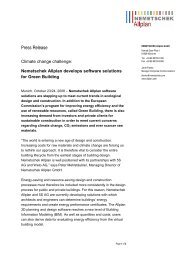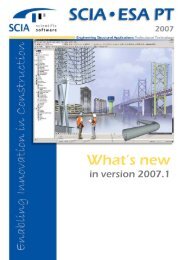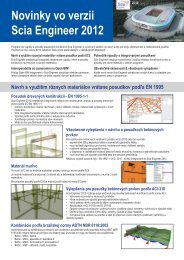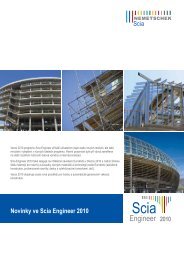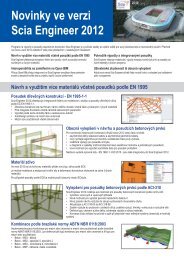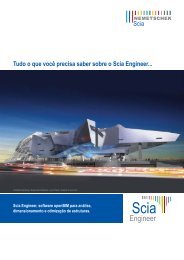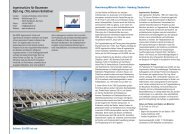VSH Turòa nad Bodvou - Nemetschek Scia
VSH Turòa nad Bodvou - Nemetschek Scia
VSH Turòa nad Bodvou - Nemetschek Scia
You also want an ePaper? Increase the reach of your titles
YUMPU automatically turns print PDFs into web optimized ePapers that Google loves.
Introduction<br />
Anyone driving from Heerenveen to the Afsluitdijk over the A7<br />
will discover that Sneek is still a considerable hindrance - the A7<br />
motorway is interrupted by a 4-kilometre stretch of the N7 bypass to<br />
the south of Sneek. This situation will last until mid-2008 when the<br />
last section of N7 will have been upgraded to the A7 motorway.<br />
The eastern half of this southern bypass section will be upgraded<br />
over the existing route. About midway along the existing N7<br />
section, the river Geeuw, the railway line from Sneek to Stavoren,<br />
the exit road Sneek-IJlst and a dikeroad will be crossed by the<br />
route of the new A7 motorway. In this new situation there will<br />
be an aqueduct under the Geeuw, at which over the access road<br />
on the west side viaducts will be constructed for the railway, the<br />
Sneek-IJlst road and in addition a local road that runs over the Alde<br />
Himdyk. The western half of the new A7 branches away from the<br />
existing N7 from the aqueduct and goes round the business park<br />
De Hemmen for which there are expansion plans.<br />
Geeuw project<br />
The structural Geeuw project is divided into ten subway sections,<br />
one water cistern, two prefab traffic viaducts, one railway viaduct<br />
and one aqueduct with the connecting pieces and caps. All insitu<br />
concrete structures were detailed by Witteveen+Bos, see next<br />
page. The railway viaduct was detailed by TCE.<br />
Railway viaduct<br />
The Sneek-Stavoren line is a single-track, non-electrified railway. The<br />
railway viaduct over the entrance to the aqueduct is constructed as<br />
a pre-stressed trough beam. The beam was placed directly on the<br />
corners (without intermediate abutments) on four bored piles. The<br />
piles were placed at night when the line was out of service.<br />
Railway of ‘Geeuw’ aquaduct<br />
The project concerned a railway viaduct for the Sneek-<br />
Stavoren line, this is a single-track, non-electrified railway.<br />
The railway viaduct is constructed as a pre-stressed trough<br />
beam. The beam was placed directly on the corners (without<br />
intermediate abutments) on four bored piles. The piles were<br />
placed at night when the line was out of service. These<br />
concrete piles are 1.2 metres in diameter and are approximately<br />
36 metres deep. They are reinforced over the top 14<br />
metres.<br />
The rail trough is completely separate from the aqueduct.<br />
Only the final transverse restraint of the trough is carried<br />
by the outer walls of the underlying aqueduct. The railway<br />
trough was constructed next to the railway dike and was slid<br />
into place in September 2006, with the railway being out of<br />
service for less than a weekend.<br />
These concrete piles are 1.2 metres in diameter and are approximately<br />
36 metres deep. They are reinforced over the top 14<br />
metres.<br />
The rail trough is completely separate from the aqueduct. Only the<br />
final transverse restraint of the trough is carried by the outer walls<br />
of the aqueduct. The railway trough was constructed raised next<br />
to the railway dike and was slid into place in September 2006, with<br />
the railway being out of service for less than a weekend. Following<br />
this, the construction of the aqueduct that runs underneath was<br />
begun.<br />
The aqueduct crosses the railway at an angle of approximately 67°.<br />
The bored piles under the railway trough are positioned at right<br />
angles to the railway line at each end of the trough viaduct. The<br />
spanning of the trough is approximately 33 metres, at a construction<br />
height of 2.15 metres. The floor screed is 0.65 metres thick.<br />
Project strategy<br />
The railway viaduct is a slender design with relatively thin trough<br />
walls. Thus the percentage of reinforcement in the walls and<br />
floors is high. A large amount of reinforcement comes together<br />
at the end of the trough beams. The distribution of forces from<br />
the prestressing anchors results in a quantity of split reinforcement.<br />
The encasement tube for the prestressing cables runs through the<br />
split reinforcement. The split reinforcement is crossed by reinforcement<br />
from the floor. This reinforcement functions as a tension<br />
rod between the two walls. In addition, the walls of the trough<br />
beam are reinforced by transverse braces, torsion braces, flank<br />
bars, suspended reinforcement for the floor and compression<br />
reinforcement. Compression reinforcement is required to meet<br />
the ultimate limiting condition for the compression zone height to<br />
prevent brittle failure of the structure. This quantity of reinforcing<br />
steel can lead to problems if the position of the bars is not carefully<br />
worked out. The use of Allplan enabled a number of conflict<br />
points to be solved immediately by making certain bars a different<br />
shape. Checking the complex reinforcement is now much easier<br />
for the structural engineer, because the reinforcement can be seen<br />
on a 3D animation screen. A three-dimensional image in combination<br />
with two-dimensional cross-sections gives a good picture of<br />
the actual situation. This manner of working has helped to avoid a<br />
large number of conflict points during construction.<br />
Project technical data<br />
Project name: Construction of Geeuw aqueduct Sneek<br />
Principal: Province of Friesland / ProRail<br />
Location: Sneek<br />
Length: 38,95 metres<br />
Span: 32,95 metres<br />
Width: 7,45 metres<br />
Height: 1,95 metres<br />
Quantity of concrete: approx. 310 m³<br />
Quantity of steel reinforcement: approx. 53,000 kg<br />
Realisation Geeuwaquaduct Sneek - Spooraquaduct<br />
65





